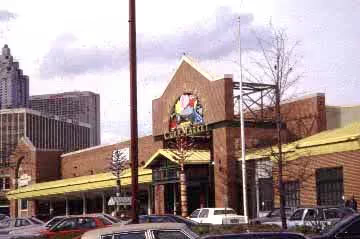A biweekly newsletter with public space news, resources, and opportunities.
A curated dispatch on all things public markets plus the latest announcements from the Market Cities Program.
Please note that these Hall of Shame nominations were written in a moment in time (most over a decade ago) and likely have since changed or even been transformed. If the above entry is now great, or still not so great, go ahead and comment below on how it has evolved or nominate it as a great place.

An enclosed market located in the geographic heart of Atlanta.

Located in the historic Sweet Auburn area - one of the most notable black business districts in the U.S. and childhood home of Dr. Martin Luther King, Jr. - the curb market sells groceries and fresh produce, including regional and ethnic items such as ham hocks and chitlins. The market is a tangible link to the area's rich heritage and history, yet it remains vital and bustling with activity.
By the early 1900's, the industrial revolution had removed many people from their agrarian roots. Interest in public markets surged as a way to give urban consumers direct access to farmers and their products, as they had had in the "good old days."
In 1918 Atlanta established a farmer's market on land cleared by a massive fire which had swept through the city the year before. The market was an immediate success, reportedly soon enclosed by a tent. Wishing to give the market a more permanent home, the Woman's Club of Atlanta raised "seed money" and A. Ten Eyck Brown was commissioned to design the structure.
The fireproof brick and concrete building opened May 1, 1924, as the Municipal Market of Atlanta, in the exact geographic center of Atlanta. It shortly became the largest single retail center for farm products in the state. It truly was "the place to shop" for every Atlantan. A segregated city at the time, however, Atlanta's racial divisions were reflected in the market: blacks were only permitted to patronize stalls lining the curb, while whites shopped within. The market's current name refers to this era.
The end of World War II was the start of several socio-economic trends that have contributed to the market's current state. First was suburbanization, with many people moving out of downtown and taking their shopping needs with them. Full service supermarkets, which even today are becoming more and more complete in their product offerings, sprang up to serve growing populations. Second was urban renewal, aimed at improving the inner-city. Unfortunately, the many fine facilities this program provided, such as the Downtown Connector and the Civic Center, came at the expense of downtown housing. The market's natural consumer base eroded at an alarming pace.
In 1994 the market underwent a massive renovation and was renamed just prior to a visit from President Bill Clinton.
*Please note that these Hall of Shame nominations were written in a moment in time (most over a decade ago) and likely have since changed or even been transformed. If the above entry is now great, or still not so great, go ahead and comment below on how it has evolved or nominate it as a great place.